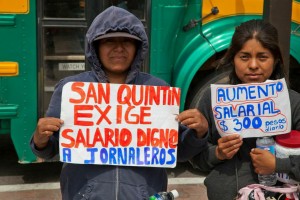 The millions made in profits and the prosperity of the big growers contrasts sharply to the biting poverty of the men and women who work their fields in the San Quintin Valley of Baja California. The conditions they suffer have been revealed following the movement launched by day laborers several months ago.
The millions made in profits and the prosperity of the big growers contrasts sharply to the biting poverty of the men and women who work their fields in the San Quintin Valley of Baja California. The conditions they suffer have been revealed following the movement launched by day laborers several months ago.
On May 8 marks the last day of the window of time given to the sub-secretary of the Interior Ministry, Luis Enrique Miranda Nava, to respond to the demands of the day laborers. Whether or not the government accepts the demands, the movement of thousands of fieldworkers has already revealed the profound contradictions of the neoliberal economy model. This model has been heavily promoted by the Mexican government policy since the administration of Carlos Salinas de Gortari (1988-1994).
After the uprising of around 80,000 workers of the San Quintín Valley on March 17, the Agricultural Advisors of Baja California offered a 15% wage hike. The workers rejected the offer, and since then there have been no negotiations between the representatives of the laborers and the government.
The workers, spearheaded by the National, State, and Municipal Alliance of Social Justice Organizations, want a raise to 200 pesos ($13.00 USD) a day. They initially asked for 300 pesos, or $20.00 USD. They have demanded 20 pesos a box for strawberries, 17 pesos for blackberries, 17 pesos for a box for cranberries, and 8 pesos for a bucket of tomatoes picked.
Currently, farm worker wages vary. For example, workers get more or less depending on whether it is high or low harvest season and on which farm the laborer works. A worker with an eight-hour shift usually earns between 115 pesos ($7.66 USD) and 130 pesos ($8.66 USD) a day.
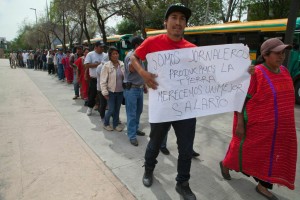
Other demands of the movement include eliminating child labor and sexual assaults on women in the fields; providing basic services such as a sewage system, drinkable water and electricity; and decent housing.
One of the preliminary agreements with Baja California state officials, in coordination with the Mexican Social Security Institute (MSSI), was to affiliate the farm workers so they have access to medical attention.
The Alliance has carried out several mobilizations and a long march to Mexicali, the state capital, to call attention to the farm worker demands. They have also traveled to Mexico City to call for the intervention of the federal government to help resolve the problems facing the workers.
On April 24, thousands of day laborers organized again in San Quintin, to receive Sub-Secretary Miranda Nava and a delegation made up of representatives from the MSSI, the Labor Ministry, and a committee of Senate and House members.
Miranda Nava agreed to carry out supervisions in several agricultural companies, in coordination with the Ministry of Labor, the Social Security Institute and the Ministry of Social Development to draw up a pronouncement that would call on the agro-export producers to restart negotiations with the Alliance based on a finding that the workers’ demands are substantiated.
The Alliance hopes for an announcement of a wage hike and not simply another proposal, according to Fidel Sánchez Gabriel, an indigenous Oaxacan and a spokesperson for the movement.
The demand is based on inspections of 60 farms in the area, most operated by transnational companies, the leader explained.
Possible International Boycott
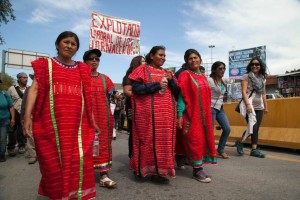
In an interview with the Americas Program, Sanchez emphasized that May 8 is the deadline for the government and producers to announce their decision to return to the negotiating table. If the growers continue to reject the workers’ demands, mainly for the wage hike, the workers plan to call an international boycott on agricultural products from the San Quintin Valley.
The region grows and harvests tons of strawberries, raspberries, cranberries and blackberries. It also produces tomatoes, cucumbers, peas, squash, Brussels sprouts, chili peppers, carrots, broccoli and green onions, among other vegetables. The main markets are the cities of the United States, Great Britain, China and Japan.
At the beginning of the labor movement, Baja California governor, Francisco Vega de Lamadrid, acknowledged that on the first day of the work stoppage, the region lost income of some 30 million dollars.
“We say that shows they can pay the amount we are asking for because every day, in Baja California, they’re making these 30 million dollars. So why are they telling us they aren’t able to give us a raise?”, Sanchez asked.
The leader of the day laborers repeated that if there isn’t a favorable answer on May 8, they will broaden the grassroots protest to bring in the demands of all the day laborers in the country. He added that there would no longer be compromises with the producers.
The movement would go to the next phase of calling for an international economic boycott. The members of the Alliance also plan to begin a tour of all the states of Mexico to find out if the nearly 6 million day laborers throughout the country are facing conditions similar to those in San Quintin. Based on their discovery, they plan to organize a national farm workers’ movement.
Support from the United States
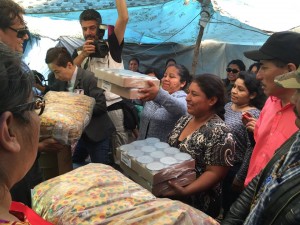
In early May, hundreds of indigenous laborers from San Quintin received a caravan of humanitarian aid made up of members of the Indigenous Front of Binational Organizations (FIOB, by its Spanish initials), Local 770 of the International United Food and Commercial Workers (UFCW), the Oaxacan Regional Organization (ORO), Calli Ollin, the Proyecto Mixteco / Indigenous Community Organization (MICOP) and the Binational Center for Oaxacan Indigenous Development (CBDIO).
Visitors not only brought food support but also gave workshops on labor rights, rights of indigenous peoples and gender.
Sanchez has faith that the workers will continue to receive the support of organizations and unions in the United States that have expressed their solidarity.
“We´ll see who are the ones who are truly with the Mexican laborers’ movement and who are the ones just seeking to be protagonists now that there is a strong movement of laborers of the San Quintin Valley,” he said.
He confirmed that some 80,000 laborers stood up to fight for their rights on March 17 and there could be many more if the movement spreads nationwide.
“We who live in the San Quintin Valley are the ones who rose up that day and we showed our strength by demonstrating at the different strategic points, from the delegation of Punta Colonet to Santa Maria Los Pinos”, Sanchez said. The peasant leader was referring to the north and south poles of the San Quintin Valley, between the townships of Tijuana and Ensenada. This was where the workers staged the first road block of the trans-peninsular highway, in addition to takeovers of municipal offices.
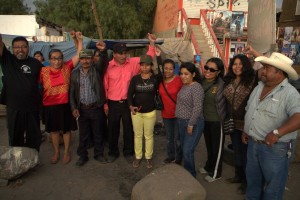 Sanchez acknowledges that many of his fellow workers have had to return to their work under protest because they can’t afford to lose an income to feed their families.
Sanchez acknowledges that many of his fellow workers have had to return to their work under protest because they can’t afford to lose an income to feed their families.
However, he said that support for workers remains strong. In the demonstration on April 24 workers participated from Punta Colonet, Ejido Diaz Ordaz, Camalú, Military Colonia Vicente Guerrero, Santa Fe, Father Kino, Graciano Sánchez, Leandro Valle, Las Flores, the San Francisco development, Santa Maria Los Pinos, Francisco Villa, Los Arcos the Ejido Papalote, New Era, Colonia Benito Garcia and New Mexico, Morelos, Lopez Mateos, Flores Magon and Lazaro Cardenas.
Long-term struggle
Gaspar Rivera Salgado, researcher Labor Center at the University of California at Los Angeles (UCLA), states that the situation of agricultural workers Valle de San Quintin—made up of half (40,000) indigenous Oaxacan migrants–is very complex and has long-term implications.
In an interview with the Americas Program, he noted the extreme poverty in the settlements where the laborers live without basic services like water, electricity, drainage and street paving.
The struggle of the laborers of San Quentin has exposed the deep contradictions of an economic model that works only for the benefit of a few and punishes the majority, said the Mixtec sociologist. Despite hours of back-breaking work in the fields, the farm laborers live in precarious conditions.
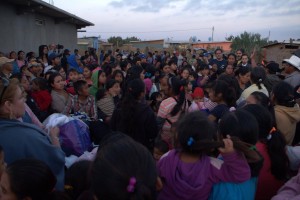
One huge obstacle to organizing in defense of their rights is that the San Quentin workers face a gigantic control apparatus in the form of “white” and “charro” unions imposed by the Confederation of Workers of Mexico (CTM) the Revolutionary Confederation of Workers and Peasants (CROC) and the Regional Confederation of Mexican Workers (CROM). “White unions” are unions that only exist on paper and charro unions are run by the labor centrals. Niether represents the interests of the workers, yet the growers exclusively recognize these unions in negotations as the workers’ representation.
To break this pattern and have a more effective impact, organizational long-term strategy is needed, says professor Rivera Salgado. This strategy should include the development of organizational capacity and leadership.
Rivera Salgado, also a founding member of FIOB, states that when he arrived in San Quentin with the aid convoy he witnessed the determination of the indigenous youth to learn to fight for their rights. During talks with young people taking part of in the work stoppage at San Quentin, and in organizing workshops, young agricultural workers expressed their commitment to defend their rights in a struggle that could spread out over several generations.
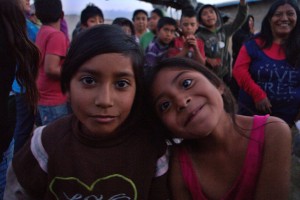
The farmworker leader Fidel Sanchez agrees that the workers are in for the long haul. “We are fighting against the three largest powers in Mexico: a government that cares little for the workers, the power of money of the growers—members of the political elite, and the power of the unions that are allied with agribusiness.”
“Our lives are at stake and we are big now, but we want the fight to never end. If something were to happen to us us, we want young people to continue fighting for their rights,” Sanchez concluded.
Bertha Rodríguez Santos is a journalist, contributor the the Americas Program www.americas.org and member of FIOB.



